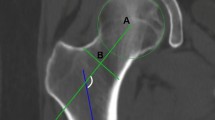Abstract
Objective
To correlate MRI findings of quadratus femoris muscle edema (QFME) with narrowing of the ischiofemoral space (IFS) and quadratus femoris space (QFS) in children, and to identify threshold values reflecting an anatomic architecture that may predispose to ischiofemoral impingement.
Materials and methods
A case-control retrospective MRI review of 49 hips in 27 children (mean, 13 years) with QFME was compared to 49 hips in 27 gender and age-matched controls. Two radiologists independently measured IFS and QFS. Generalized linear mixed-effects models were fit to compare IFS and QFS values between cases and controls, and adjust for correlation in repeated measures from the same subject. Receiver operating characteristic (ROC) analysis determined optimal threshold values.
Results
Compared to controls, cases had significantly smaller IFS (p < 0.001, both readers) and QFS (reader 1: p < 0.001; reader 2: p = 0.003). When stratified as preteen (< 13) or teenage (≥ 13), lower mean IFS and QFS were observed in cases versus controls in both age groups. Area under ROC curve for IFS and QFS was high in preteens (0.77 and 0.71) and teens (0.94 and 0.88). Threshold values were 14.9 mm (preteens) and 19 mm (teens) for IFS and 11.2 mm (preteens) and 11.1 mm (teens) for QFS. IFS and QFS were modestly correlated with age among controls only.
Conclusions
Pediatric patients with QFME had significantly narrower QFS and IFS compared with controls. IFS and QFS were found to normally increase in size with age. Optimal cutoff threshold values were identified for QFS and IFS in preteens and teenagers.

Similar content being viewed by others
References
Johnson KA. Impingement of the lesser trochanter on the ischial ramus after total hip arthroplasty. Report of three cases. J Bone Joint Surg Am. 1977;59(2):268–9.
Torriani M, Souto SC, Thomas BJ, Ouellette H, Bredella MA. Ischiofemoral impingement syndrome: an entity with hip pain and abnormalities of the quadratus femoris muscle. AJR Am J Roentgenol. 2009;193(1):186–90.
Tosun O, Algin O, Yalcin N, Cay N, Ocakoglu G, Karaoglanoglu M. Ischiofemoral impingement: evaluation with new MRI parameters and assessment of their reliability. Skelet Radiol. 2012;41(5):575–87.
Singer AD, Subhawong TK, Jose J, Tesley J, Clifford PD. Ischiofemoral impingement syndrome: a meta-analysis. Skelet Radiol. 2015;44(6):831–7.
Stenhouse G, Kaiser S, Kelley SP, Stimec J. Ischiofemoral impingement in children: imaging with clinical correlation. AJR. 2016;206:426–30.
Tosun O, Cay N, Bozkurt M, Arslan H. Ischiofemoral impingement in an 11-year –old girl. Diagn Interv Radiol. 2012;18(6):571–3.
Truong WH, Murnaghan M, Hopyn S, Kelley SP. Ischioplasty for femoroischial impingement. JBJS Case Connect. 2012;26:2.
Ali AM, Whitwell D, Ostlere SJ. Case report: imaging and surgical treatment of a snapping hip due to ischiofemoral impingement. Skelet Radiol. 2011;40(5):653–6.
Dong C, Nowakowski AM, Kreig AH. Bilateral ischiofemoral impingement: a case report and literature review. J Ortho Bone Disord. 2017;1(4):0000120.
Hernando MF, Cerezal L, Perez-Carro L, Abascal F, Canga A. Deep gluteal syndrome: anatomy, imaging, and management of sciatic nerve entrapments in the subgluteal space. Skelet Radiol. 2015;44(7):919–34.
Bredella MA, Azevedo DC, Oliviera AL, Simeone FJ, Chang CY, Stubbs AJ, et al. Pelvic morphology in ischiofemoral impingement. Skelet Radiol. 2015;44(2):249–53.
Taneja AK, Bredella MA, Ischiofemoral Impingement TM. Magn Reson Imaging Clin N Am. 2013;21:65–73.
Singer A, Clifford P, Tesley J, Jose J, Subhawong T. Ischiofemoral impingement and the utility of full range of motion MRI in its detection. Am J Orthop. 2014;43(12):548–51.
Ozdemir ZM, Aydingoz U, Goremeli CA, Kahraman AS. Ischiofemoral space on MRI in an asymptomatic population: normative width measurements and soft tissue signal variations. Eur Radiol. 2015;25:2246–53.
Papavasiliou A, Siatras T, Bintoudi A, Milosis D, Lallas V, Sykaras E, et al. The gymnasts’ hip and groin: a magnetic resonance imaging study in asymptomatic elite athletes. Skelet Radiol. 2014;43:1071–7.
Acknowledgements
We thank Dr. Judah Goldschmidt for his help in the early phase of this research. We thank Dr. Mimi Kim for her help and oversight of the statistical analyses.
Author information
Authors and Affiliations
Corresponding author
Ethics declarations
Conflict of interest
The authors declare that they have no conflicts of interest.
Rights and permissions
About this article
Cite this article
Goldberg-Stein, S., Friedman, A., Gao, Q. et al. Narrowing of ischiofemoral and quadratus femoris spaces in pediatric ischiofemoral impingement. Skeletal Radiol 47, 1505–1510 (2018). https://doi.org/10.1007/s00256-018-2962-0
Received:
Revised:
Accepted:
Published:
Issue Date:
DOI: https://doi.org/10.1007/s00256-018-2962-0




